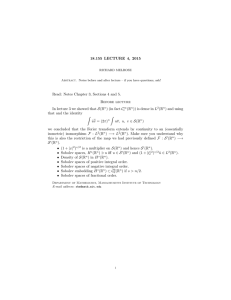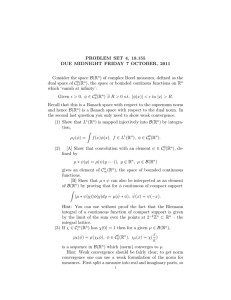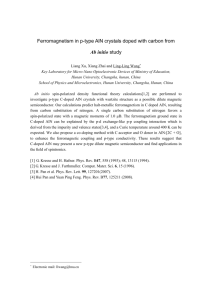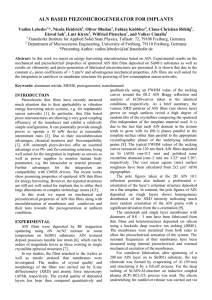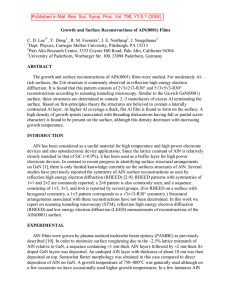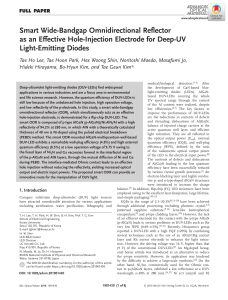10. Sobolev embedding
advertisement
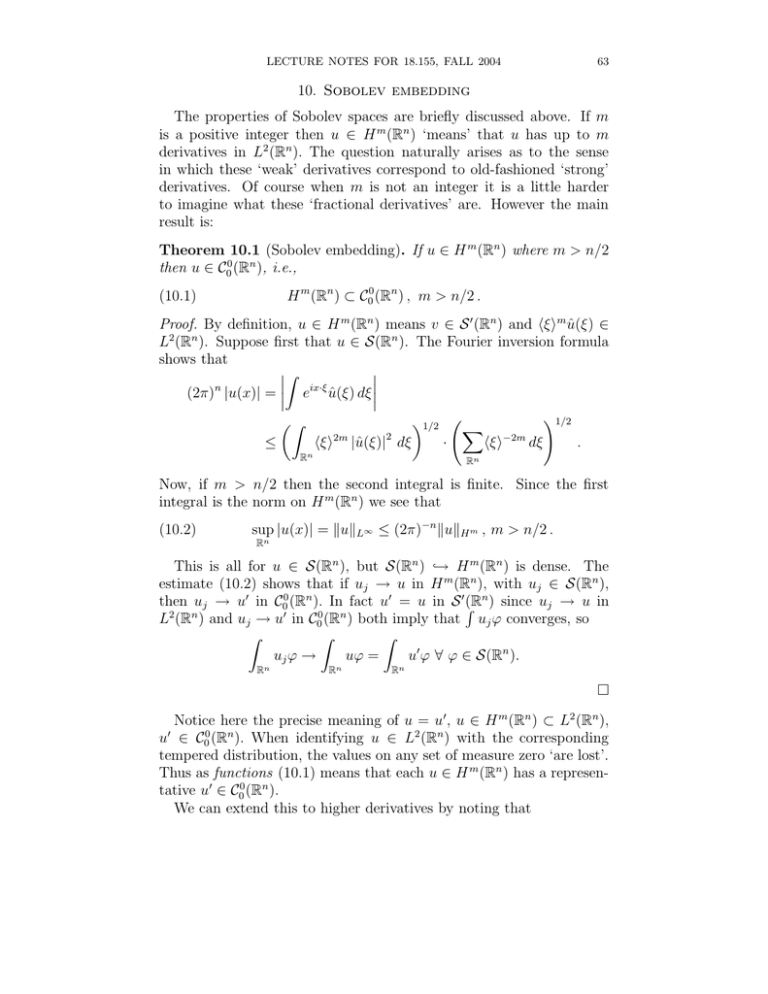
LECTURE NOTES FOR 18.155, FALL 2004 63 10. Sobolev embedding The properties of Sobolev spaces are briefly discussed above. If m is a positive integer then u → H m (Rn ) ‘means’ that u has up to m derivatives in L2 (Rn ). The question naturally arises as to the sense in which these ‘weak’ derivatives correspond to old-fashioned ‘strong’ derivatives. Of course when m is not an integer it is a little harder to imagine what these ‘fractional derivatives’ are. However the main result is: Theorem 10.1 (Sobolev embedding). If u → H m (Rn ) where m > n/2 then u → C00 (Rn ), i.e., H m (Rn ) � C00 (Rn ) , m > n/2 . (10.1) Proof. By definition, u → H m (Rn ) means v → S � (Rn ) and ⊂π≤mû(π) → L2 (Rn ). Suppose first that u → S(Rn ). The Fourier inversion formula shows that � �� � � ix·α n ˆ dπ �� (2�) |u(x)| = �� e u(π) �1/2 �� �1/2 �� 2 −2m 2m ⊂π≤ dπ ∀ ⊂π≤ |ˆ(π)| u dπ · . Rn Rn Now, if m > n/2 then the second integral is finite. Since the first integral is the norm on H m (Rn ) we see that (10.2) sup |u(x)| = ∈u∈L� ∀ (2�)−n ∈u∈H m , m > n/2 . Rn This is all for u → S(Rn ), but S(Rn ) γ� H m (Rn ) is dense. The estimate (10.2) shows that if uj � u in H m (Rn ), with uj → S(Rn ), n ) since uj � u in then uj � u� in C00 (Rn ). In fact u� = u in S � (R 2 n � 0 n L (R ) and uj � u in C0 (R ) both imply that uj α converges, so � � � uj α � uα = u� α � α → S(Rn ). Rn Rn Rn � Notice here the precise meaning of u = u� , u → H m (Rn ) � L2 (Rn ), u → C00 (Rn ). When identifying u → L2 (Rn ) with the corresponding tempered distribution, the values on any set of measure zero ‘are lost’. Thus as functions (10.1) means that each u → H m (Rn ) has a represen­ tative u� → C00 (Rn ). We can extend this to higher derivatives by noting that � 64 RICHARD B. MELROSE Proposition 10.2. If u → H m (Rn ), m → R, then D � u → H m−|�| (Rn ) and (10.3) D � : H m (Rn ) � H m−|�| (Rn ) is continuous. Proof. First it is enough to show that each Dj defines a continuous linear map (10.4) Dj : H m (Rn ) � H m−1 (Rn ) � j since then (10.3) follows by composition. � If m → R then u → H m (Rn ) means u ˆ → ⊂π≤−m L2 (Rn ). Since D ju = πj · u ˆ, and |πj | ⊂π≤−m ∀ Cm ⊂π≤−m+1 � m we conclude that Dj u → H m−1 (Rn ) and ∈Dj u∈H m−1 ∀ Cm ∈u∈H m . � Applying this result we see Corollary 10.3. If k → N0 and m > (10.5) n 2 + k then H m (Rn ) � C0k (Rn ) . Proof. If |�| ∀ k, then D � u → H m−k (Rn ) � C00 (Rn ). Thus the ‘weak derivatives’ D � u are continuous. Still we have to check that this means that u is itself k times continuously differentiable. In fact this again follows from the density of S(Rn ) in H m (Rn ). The continuity in (10.3) implies that if uj � u in H m (Rn ), m > n2 + k, then uj � u� in C0k (Rn ) (using its completeness). However u = u� as before, so u → C0k (Rn ). � In particular we see that (10.6) H � (Rn ) = � H m (Rn ) � C � (Rn ) . m These functions are not in general Schwartz test functions. Proposition 10.4. Schwartz space can be written in terms of weighted Sobolev spaces � (10.7) S(Rn ) = ⊂x≤−k H k (Rn ) . k LECTURE NOTES FOR 18.155, FALL 2004 65 Proof. This follows directly from (10.5) since the left side is contained in � ⊂x≤−k C0k−n (Rn ) � S(Rn ). k � Theorem 10.5 (Schwartz representation). Any tempered distribution can be written in the form of a finite sum � (10.8) u = x� Dx� u�� , u�� → C00 (Rn ). |�|�m |�|�m or in the form (10.9) u= � Dx� (x� v�� ), v�� → C00 (Rn ). |�|�m |�|�m Thus every tempered distribution is a finite sum of derivatives of continuous functions of poynomial growth. Proof. Essentially by definition any u → S � (Rn ) is continuous with re­ spect to one of the norms ∈⊂x≤k α∈C k . From the Sobolev embedding theorem we deduce that, with m > k + n/2, |u(α)| ∀ C∈⊂x≤k α∈H m � α → S(Rn ). This is the same as � −k � �⊂x≤ u(α)� ∀ C∈α∈H m � α → S(Rn ). which shows that ⊂x≤−k u → H −m (Rn ), i.e., from Proposition 9.8, � ⊂x≤−k u = D � u� , u� → L2 (Rn ) . |�|�m In fact, choose j > n/2 and consider v� → H j (Rn ) defined by v̂� = ⊂π≤−j u ˆ� . As in the proof of Proposition 9.14 we conclude that � � � u� = , u�,� → H j (Rn ) � C00 (Rn ) . D � u�,� |�|�j Thus,17 (10.10) u = ⊂x≤k � D�� v� , v� → C00 (Rn ) . |�|�M To get (10.9) we ‘commute’ the factor ⊂x≤k to the inside; since I have not done such an argument carefully so far, let me do it as a lemma. 17This is probably the most useful form of the representation theorem! 66 RICHARD B. MELROSE Lemma 10.6. For any � → Nn0 there are polynomials p�,� (x) of degrees at most |� − �| such that � � � ⊂x≤k D � v = D �−� p�,� ⊂x≤k−2|�−�| v . ��� Proof. In fact it is convenient to prove a more general result. Suppose p is a polynomial of a degree at most j then there exist polynomials of degrees at most j + |� − �| such that � (10.11) p⊂x≤k D � v = D �−� (p�,� ⊂x≤k−2|�−�| v) . ��� The lemma follows from this by taking p = 1. Furthermore, the identity (10.11) is trivial when � = 0, and proceed­ ing by induction we can suppose it is known whenever |�| ∀ L. Taking |�| = L + 1, � D � = Dj D � |� � | = L. Writing the identity for � � as � � � � � � p⊂x≤k D � = D � −� (p�� ,� � ⊂x≤k−2|� −� | v) �� �� � we may differentiate with respect to xj . This gives � p⊂x≤k D � = −Dj (p⊂x≤k ) · D � v � � + D �−� (p��� ,� � ⊂x≤k−2|�−�|+2 v) . |�� |�� The first term on the right expands to 1 � � (−(Dj p) · ⊂x≤k D � v − kpxj ⊂x≤k−2 D � v) . i We may apply the inductive hypothesis to each of these terms and rewrite the result in the form (10.11); it is only necessary to check the order of the polynomials, and recall that ⊂x≤2 is a polynomial of degree 2. � Applying Lemma 10.6 to (10.10) gives (10.9), once negative powers of ⊂x≤ are absorbed into the continuous functions. Then (10.8) follows from (10.9) and Leibniz’s formula. �



